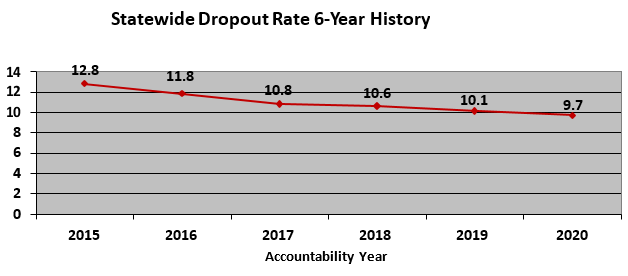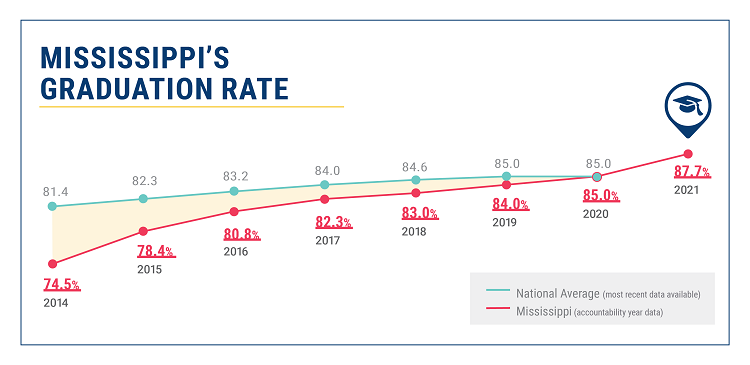Graduating from high school is a strong predictor of adult success which includes physical and mental health outcomes. Mississippi is committed to improving the number of students who graduate each year college and Career Ready (State Board Goal 2). As required by state law, each school district shall implement an annual dropout prevention plan. The plan must be board approved and posted on the district website homepage by August 1st of each school year.
Each high school with a graduation rate below 85% is required to develop a graduation restructuring plan. Representatives from the feeder middle schools should be included in the restructuring planning team. The newly created dropout Prevention/ Restructuring Plan is due to Danny Rochelle, drochelle@mdek12.org.
How are “repeaters,” or students that do not graduate within four years included in the calculation of graduation rates?
Mississippi calculates graduation rates consistent with federal requirements for a four-year adjusted cohort graduation rate method. Every student in the four-year cohort is assigned one of five statuses: Graduate, Dropout, Completer, Still Enrolled, or Excluded. Excluded students are those who move out of state, transfer to home school, transfer to private school, or are deceased during the four-year cohort timeframe. Still Enrolled are students that continue enrollment beyond the four-year timeframe. These may be students that needed to repeat a grade or are students with an Individualized Education Plan (IEP) that continues beyond four years. A chart of student code designations may be found on page nine of the Mississippi Department of Education’s Four-Year Adjusted Cohort Graduation and Completion Calculation Guidance document. These five categories are mutually exclusive; and therefore, students with a status of still enrolled (repeaters) are not included in the graduation rate, nor the dropout rate. Below is an example of how counts for each category are computed to arrive at the graduation rate calculation (percent).
|
Four-year Adjusted Cohort Denominator |
Four-year Adjusted Cohort Graduation Rate Numerator |
Four-year Adjusted Cohort Completion Rate Numerator |
Four-year Adjusted Cohort Dropout Rate Numerator |
Four-year Adjusted Cohort Still-Enrolled Rate Numerator |
|
33936 |
28851 |
1095 |
3308 |
682 |
In this example, the graduation rate would be calculated as 85.0% (28,851/33,936), and the dropout rate would be calculated as 9.7% (3308/33936). Separate rates are calculated and reported to each school district for the remaining categories of completion and still enrolled. Each district receives a detailed report with all four rates, including an individual student report that includes the category designation for each student.
Is the drop-out rate that is publicly reported a four-year adjusted cohort dropout rate or not?
Although the Unites States Department of Education (USDE) does not require the reporting of a dropout rate by states, the MDE does report the number of students in the four-year adjusted cohort who dropped out at any time during the four-year timeframe. The USDE does collect completer and dropout annual counts (not associated with a cohort) from each state. So, it is possible to find Federally reported annual counts and/or rates for dropouts; however, it should be noted that Federal dropout rates are not calculated as a four-year cohort rate. The USDE calculates a “status dropout rate” which considers whether a person earns a diploma or GED by the age of 24. For the purposes of clarity and consistency, MDE reports all “rates” using the four-year adjusted cohort method.
Top 10 Districts with the Highest Graduation Rates
|
Rank |
District |
Graduation Rate |
|
1 |
Mississippi School of the Arts |
100.0% |
|
2 |
Mississippi School for Math and Science |
98.1% |
|
3 |
Enterprise School District |
97.1% |
|
4 |
George County School District |
95.3% |
|
5 |
South Delta School District |
95.1% |
|
6 |
Alcorn School District |
94.7% |
|
7 |
Bay St Louis Waveland School District |
93.5% |
|
8 |
Tunica County School District |
93.1% |
|
9 |
Poplarville Separate School District |
92.6% |
|
10 |
Tishomingo County School District |
92.5% |
Notes:
- Ranking does not include suppressed data.
- The table excludes districts that have been abolished due to consolidation.
Top 10 Districts with the Lowest Dropout Rates
|
Rank |
District |
Dropout Rate |
|
1 |
Mississippi School of the Arts |
0.0% |
|
2 |
South Delta School District |
1.6% |
|
3 |
Mississippi School for Math and Science |
1.9% |
|
4 |
Alcorn School District |
2.2% |
|
5 |
West Jasper Consolidated Schools |
2.4% |
|
6 |
Enterprise School District |
2.9% |
|
6 |
George County School District |
2.9% |
|
6 |
East Jasper Consolidated |
2.9% |
|
7 |
Jefferson Davis County School District |
3.1% |
|
8 |
Pass Christian Public School District |
3.3% |
|
8 |
Jefferson County School District |
3.3% |
|
9 |
Lamar County School District |
3.5% |
|
10 |
Kemper County School District |
3.6% |
|
10 |
Bay St Louis Waveland School District |
3.6% |
|
10 |
Leland School District |
3.6% |
Notes:
- Ranking does not include suppressed data.
- The table excludes districts that have been abolished due to consolidation.

For information on dropout rates for your school/district and other key findings, consult the Accountability System District Graduation and Dropout Rates
The Difference Between Graduation Rate and Dropout Rate
In considering the annual dropout rate, it is critical to note that this rate is not the same as the four-year cohort graduation rate. The cohort graduation rate follows a group of ninth graders across four years’ time and reports the percentage of these students who graduate four years after beginning high school.
The annual dropout rate illustrates the number and percentage of students who drop out during one year’s time. Some of these students may return to school the following year and complete high school while others may drop out multiple times. The four-year cohort graduation rate is considered a more comprehensive picture of the issue of students’ persistence and high school completion.
- Dropout Prevention and Restructuring guidance Fall 2021
- Dropout Prevention Plan Approval Process Survey
- Dropout Prevention Plan Approval Review Rubric
- Mississippi Early Warning System PowerPoint
- Mississippi Early Warning System Guidance
- Dropout and Restructuring PowerPoint 2020
- Dropout Prevention Plan Approval Webinar
- Dropout Prevention Plan-Chapter 30-Rule 30.5
- Miss. Code Ann 37-13-80 (Dropout Prevention)
- Office of Compulsory School Attendance Enforcement




